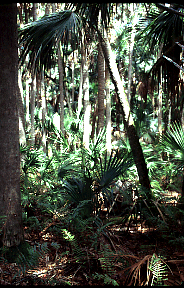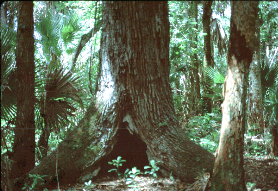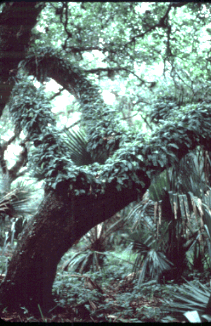Hammocks
Mesic Hardwood Hammock
Canopy
The mesic hardwood hammock is dominated by a canopy of live oak (Quercus virginiana), red mulberry (Morus rubra), and cabbage palm (Sabal palmetto). The sub-canopy includes: Redbay (Persea borbonia) and simpsons stopper (Myrcianthes fragrans var. simpsoni).
Understory
Temperate and tropical plants mix in the understory. Temperate species include beautyberry (Callicarpa americana) and shiny sumac (Rhus copallina). Marlberry (Ardisia escallonoides), shiny-leaved wild coffee (Psychotria nervosa), soft-leaved wild coffee (Psychotria sulzneri), and coralbean (Erythrina herbacea) are the tropical plants inhabiting the understory. Saw palmetto (Serenoa repens) also is common, with occasional arborescent individuals reaching heights of more than ten feet.
Ferns
In some of the lower areas, ferns cover the ground. Ferns found in the hammock include: Blechnum fern (Blechnum serrulatum), Boston fern (Nephrolepis exaltata), braken fern (Pteridium aquilinum), cinnamon fern (Osmunda cinnamomea), leather fern (Acrostichum aureum), royal fern (Osmunda regalis), and sword fern (Nephrolepis biserrata).
Epiphytes
Epiphytes abound. Golden polypody fern (Phlebodium aureum) and shoestring fern (Vittaria lineatea) adorn the cabbage palms. Live oaks, with their deeply-furrowed bark, support a large variety of epiphytes. Resurrection fern (Polypodium polypodioides) covers the bark of its massive branches, seemingly alive only when moisture is ample. Spanish moss (Tillandsia usneoides), ball moss (Tillandsia recurvata), and quill wild pine (Tillandsia setacea) festoon its bows. Water-holding bromeliads like the cardinal air plant (Tillandsia fasciculata) and the green wild pine (Tillandsia utriculata) provide a home for a rich mosquito fauna. A small population of butterfly orchids (Encyclia tampensis) also is present.
Vines
Vines also are common. Catbrier (Smilax sp.), Poison ivy (Toxicodendron radicans), Virginia creeper (Parthenocissus quinquefolia), pepper vine (Ampelopsis arborea) and possum grape (Cissus sicyoides) are among the native vines. Muscadine grape vines (Vitis munsoniana) and summer grape vines (Vitis aestivalis) produce thick, woody vines.
Tropical Hardwood Hammock
A tropical hardwood hammock grows near the warming influence of the waters of the Indian River Lagoon. The Bill Biddlingmayer Nature Trail, named in honor of a retired FMEL entomologist, traverses this unique area.
Canopy
The canopy is formed by live oak trees (Quercus virginiana), cabbage palms (Sabal palmetto), and by a large number of simpsons stoppers (Myrcianthes fragrans var. simpsoni). With their dramatic and distinctive, smooth exfoliating bark, the simpsons stopper dominate much of the hammock.
Understory
The understory includes a mix of many tropical plants, including marlberry (Ardisia escallonioides), saffron plum (Bumelia caelastrina), snowberry (Chiococca alba), white stopper (Eugenia axillaris), Spanish stopper (Eugenia foetida), coralbean (Erythrina herbacea), strangler fig (Ficus aurea), blolly (Guapira discolor), shiny-leaved wild coffee (Psychotria nervosa), myrsine (Myrsine guinanensis), white indigo berry (Randia aculeata), and wild lime (Zanthoxylum fagara). Beautyberry (Callicarpa americana), Florida privet (Forestiera segregata), and Hercules club (Zanthoxylum clava-herculis) also are present.
Vines & Epiphytes
Catbrier (Smilax auriculata) is annoyingly prevalent. Epiphytes include: Butterfly orchid (Encyclia tampensis), golden polypody fern (Phlebodium aureum), resurrection fern (Polypodium polypodioides), ball moss (Tillandsia recurvata), cardinal wild-pine (Tillandsia fasciculata), quill wild-pine (Tillandsia setacea), green wild-pine (Tillandsia utriculata), Spanish moss (Tillandsia usneoides), and shoestring fern (Vittaria lineata).
- Back to Natural Habitat at FMEL


